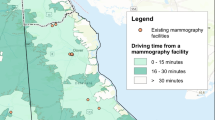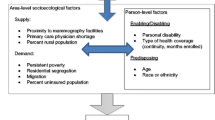Abstract
Background
The Metropolitan Chicago Breast Cancer Taskforce was formed to address a growing black/white breast cancer mortality disparity in Chicago. The Taskforce explored three hypotheses: black women in Chicago receive fewer mammograms, black women receive mammograms of inferior quality, and black women have inadequate access to quality of treatment for breast cancer.
Methods
A total of 102 individuals from 74 Chicago area organizations participated in the Task Force participating in three work groups from January to September 2007. The work groups held focus groups of providers, organized town hall meetings in four Chicago communities, gathered black/white breast cancer mortality data for Chicago, the United States, and New York City, and conducted a mammography capacity and quality survey of mammography facilities.
Results
Chicago’s black and white breast cancer mortality rates were the same in 1980. By the late 1990s, a substantial disparity was present, and by 2005, the black breast cancer mortality rate was 116% higher than the white rate. In 2007, 206,000 screening mammograms were performed for women living in Chicago, far short of the 588,000 women in the 40–69 age range in Chicago. Facilities that served predominately minority women were less likely to be academic or private institutions (p < .03), less likely to have digital mammography (p < .003), and less likely to have dedicated breast imaging specialists reading the films (p < .003). Black women and providers serving them reported significant difficulties in accessing needed care for breast cancer screening and treatment.
Conclusion
There are significant access barriers to high quality mammography and treatment services that could be contributing to the mortality differences in Chicago. A metropolitan wide taskforce has been established to address the disparity.



Similar content being viewed by others
References
Hirschman J, Whitman S, Ansell D, Grabler P, Allgood K (2006) Breast cancer in Chicago: eliminating disparities and improving mammography quality. Sinai Urban Health Institute, Chicago
Hirschman J, Whitman S, Ansell D (2007) The black: white disparity in breast cancer mortality: the example of Chicago. Cancer Causes Control 18:323–333. doi:10.1007/s10552-006-0102-y
Metropolitan Chicago Breast Cancer Taskforce (2007) Improving quality and reducing disparities in metropolitan Chicago. Chicago, IL
http://www.nber.org/data/vital-statistics-mortality-data-multiple-cause-of-death.html
http://www.accessdata.fda.gov/scripts/cdrh/cfdocs/cfMQSA/mqsa.cfm
Government Accounting Office (GAO) (2002) Mammography-capacity generally exists to deliver services. Washington, DC, Apr. report no. GAO-02-532
American College of Radiology (ACR) (2003) Breast imaging reporting and data systems (BI-RADS), 4th edn. American College of Radiology, Reston, VA
Rosenberg RD, Yankaskas BC, Abraham LA, Sickles EA, Lehman CD, Geller BM et al (2006) Performance benchmarks for screening mammography. Radiology 241(1):55–56. doi:10.1148/radiol.2411051504
Li CI, Malone KE, Darling JR (2003) Differences in breast cancer stage, treatment and survival by race and ethnicity. Arch Intern Med 163:49–56. doi:10.1001/archinte.163.1.49
Newman LA (2004) Breast carcinoma in African–American and White women: application of molecular biology to understand outcome disparities. Cancer 101:1261–1263. doi:10.1002/cncr.20501
Smith-Bindman R, Miglioretti DL, Lurie N, Abraham L, Barbash RB, Strzelczyk J et al (2006) Does utilization of screening mammography explain racial and ethnic differences in breast cancer? Ann Intern Med 144:541–553
Tammemagi CM, Nerenz D, Neslund-Dudas C, Feldkamp C, Nathanson D (2005) Comorbidity and survival disparities among Black and White Patients with breast cancer. JAMA 294:1765–1772. doi:10.1001/jama.294.14.1765
Sickles EA, Wolverton DE, Dee KE (2002) Performance parameters for screening and diagnostic mammography: specialists and general radiologists. Radiology 224:861–869. doi:10.1148/radiol.2243011482
Miglioretti DL, Smith-Bindman R, Abraham L, Brenner RJ, Carney PA et al (2007) Radiologist characteristics associated with interpretive performance of diagnostic mammography. J Natl Cancer Inst 99:1854–1863. doi:10.1093/jnci/djm238
Pisano ED, Gatsonis C, Hendrick E, Yaffe M, Baum J, Acharyya S, Conant E, Fajardo L, Bassett D’OrsiC et al (2007) Diagnostic performance of digital versus film mammography for breast-cancer screening. NEJM 353:1773–1783. doi:10.1056/NEJMoa052911
Dignam J (2000) Differences in breast cancer prognosis among African–American and Caucasian women.CA Cancer J Clin 50:50–64. doi:10.3322/canjclin.50.1.50
Fiscella PF, Gold MR, Clancy C (2000) MInequality in quality. JAMA 283:2579–2584. doi:10.1001/jama.283.19.2579
Sehgal AR (2003) Impact of quality improvement efforts on race and sex disparities in hemodialysis. JAMA 289:996–1000. doi:10.1001/jama.289.8.996
Trivedi AN, Zaslavsky A, Schneider EC, Ayanian JZ (2005) Trends in the quality of care and racial disparities in medicare managed care. NEJM 353:692–700. doi:10.1056/NEJMsa051207
Trivedi AN, Rakowski W, Ayanian JZ (2008) Effect of cost sharing on screening mammography in medicare health plans. NEJM 358:375–383. doi:10.1056/NEJMsa070929
Ferrante JM, Chen PH, The KimS (2008) Effect of patient navigation on time to diagnosis, anxiety, satisfaction in urban minority women with abnormal mammograms: a randomized controlled trial. J Urban Health 85(1):114–124
Battaglia TA, Roloff K, Posner MA, Freund KM (2007) Improving follow-up to abnormal breast cancer screening in an urban population: a patient navigation intervention. Cancer 109(2 Suppl):359–367
Acknowledgments
Funding: The Avon Foundation provided funds to support the work of the Metropolitan Chicago Breast Cancer Taskforce.
Author information
Authors and Affiliations
Corresponding author
Rights and permissions
About this article
Cite this article
Ansell, D., Grabler, P., Whitman, S. et al. A community effort to reduce the black/white breast cancer mortality disparity in Chicago. Cancer Causes Control 20, 1681–1688 (2009). https://doi.org/10.1007/s10552-009-9419-7
Received:
Accepted:
Published:
Issue Date:
DOI: https://doi.org/10.1007/s10552-009-9419-7




